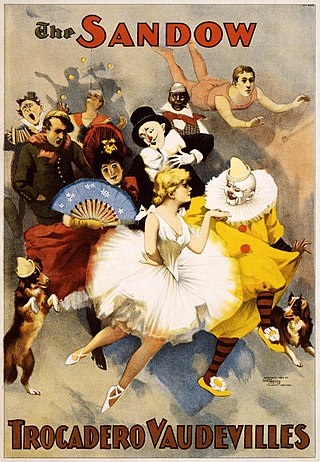
Vaudeville is a theatrical genre of variety entertainment which began in France at the end of the 19th century. A vaudeville was originally a comedy without psychological or moral intentions, based on a comical situation: a dramatic composition or light poetry, interspersed with songs or ballets. It became popular in the United States and Canada from the early 1880s until the early 1930s, while changing over time.

Jean Schwartz was a Hungarian-born Jewish American composer and pianist. He is best known for his work writing the scores for more than 30 Broadway musicals, and for his creation of more than 1,000 popular songs with the lyricist William Jerome. Schwartz and Jerome also performed together on the vaudeville stage in the United States; sometimes in collaboration with Maude Nugent, Jerome's wife, and the Dolly Sisters. Schwartz was married to Jenny Dolly from 1913 to 1921.

Jack Selig Yellen was an American lyricist and screenwriter. He is best remembered for writing the lyrics to the songs "Happy Days Are Here Again", which was used by Franklin Roosevelt as the theme song for his successful 1932 presidential campaign, and "Ain't She Sweet", a Tin Pan Alley standard.

Shuffle Along is a musical composed by Eubie Blake, with lyrics by Noble Sissle and a book written by the comedy duo Flournoy Miller and Aubrey Lyles. One of the most notable all-Black hit Broadway shows, it was a landmark in African-American musical theater, credited with inspiring the Harlem Renaissance of the 1920s and '30s.
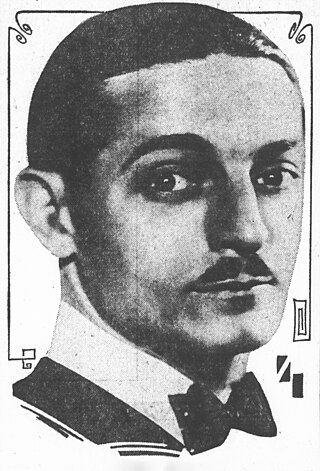
Lester M. Allen was an American actor, dancer, singer, comedian, and circus performer. After beginning his career as a child acrobat with the Barnum and Bailey Circus, he became a performer in minstrel shows, burlesque, and vaudeville. He worked as primarily a dancer and acrobat in the Broadway musical revues George White's Scandals and Ziegfeld Follies in the 1910s and early 1920s; ultimately progressing to singing and comedic acting parts. He starred as a comic actor in several musical comedies on Broadway during the 1920s and the early 1930s. He transitioned into work as a film actor, appearing in more than 15 films released from 1941 to 1950. He was killed after being struck by a motor vehicle in 1949.

James McIntyre was an American minstrel performer, vaudeville and theatrical actor, and a partner in the famous blackface tramp comedy duo act McIntyre and Heath.

Flournoy Eakin Miller, sometimes credited as F. E. Miller, was an American entertainer, actor, lyricist, producer and playwright. Between about 1905 and 1932 he formed a popular comic duo, Miller and Lyles, with Aubrey Lyles. Described as "an innovator who advanced black comedy and entertainment significantly," and as "one of the seminal figures in the development of African American musical theater on Broadway", he wrote many successful vaudeville and Broadway shows, including the influential Shuffle Along (1921), as well as working on several all-black movies between the 1930s and 1950s.

Aubrey Lee Lyles, sometimes credited as A. L. Lyles, was an American vaudeville performer, playwright, songwriter, and lyricist. He appeared with Flournoy E. Miller as Miller and Lyles as a popular African-American comedy duo from 1905 until shortly before his death. in 1929 they appeared on film as grocers in the Vitaphone Varieties short comedy film They Know Their Groceries.
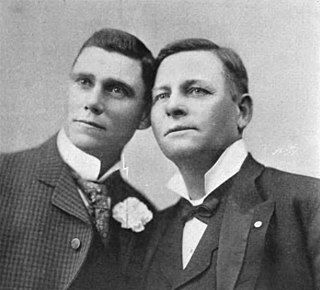
Thomas Kurton Heath (1853–1938) was a vaudeville actor with James McIntyre. They started their act in 1874.
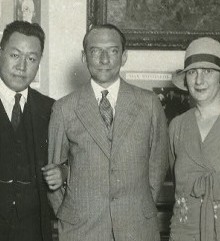
F. Ray Comstock was an American theatrical producer and theater operator. He pioneered the intimate musical comedy, staging several successful comedies at his Princess Theatre in Manhattan. He also produced spectacular musicals, variety shows and serious plays by authors such as Henrik Ibsen and Maxim Gorky.

Nan Halperin was a Russian immigrant to the USA who became a well-known singing comedian. She played in vaudeville at an early age, and later starred in musical comedies on Broadway such as Little Jessie James (1923).

Make It Snappy was a musical revue that ran for 96 performances at the Winter Garden Theatre in the 1922–23 Broadway season. It ran from 13 April to 1 July 1922. It starred Eddie Cantor, who introduced the hit songs "Yes! We Have No Bananas" and "The Sheik of Araby".

Irvin Colloden Miller was an American actor, playwright, and vaudeville show writer and producer. He was responsible for successful theater shows including Broadway Rastus (1921), Liza (1922), Dinah (1923), which introduced the wildly popular black bottom dance, and Desires of 1927 starring Adelaide Hall. For thirty years he directed the popular review, Brown Skin Models, influenced by the Ziegfeld Follies but exclusively using black performers. "In the 1920s and 1930s, he was arguably the most well-established and successful producer of black musical comedy."

George Walker and Bert Williams were two of the most renowned figures of the minstrel era. However the two did not start their careers together. Walker was born in 1873 in Lawrence, Kansas. His onstage career began at an early age as he toured in black minstrel shows as a child. George Walker became a better known stage performer as he toured the country with a traveling group of minstrels. George Walker was a "dandy", a performer notorious for performing without makeup due to his dark skin. Most vaudeville actors were white at this time and often wore blackface. As Walker and his group traveled the country, Bert Williams was touring with his group, named Martin and Selig's Mastodon Minstrels. While performing with the Minstrels, African American song-and-dance man George Walker and Bert Williams met in San Francisco in 1893. George Walker married Ada Overton in 1899. Ada Overton Walker was known as one of the first professional African American choreographers. Prior to starring in performances with Walker and Williams, Overton wowed audiences across the country for her 1900 musical performance in the show Son of Ham. After falling ill during the tour of Bandana Land in 1909, George Walker returned to Lawrence, Kansas where he died on January 8, 1911. He was 38.

The Greenwich Village Follies was a musical revue that played for eight seasons in New York City from 1919 to 1927. Launched by John Murray Anderson, and opening on July 15, 1919, at the newly constructed Greenwich Village Theatre near Christopher Street, the show's success has been credited in part to its timing: as a non-union production, it was unaffected by the then-current actors' strike.

The Earl Carroll Vanities was a Broadway revue presented by Earl Carroll in the 1920s and early 1930s. Carroll and his show were sometimes controversial.
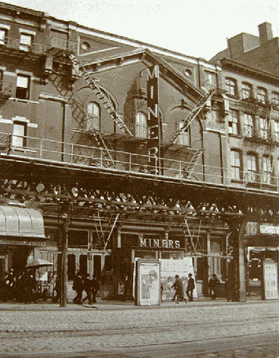
Miner's Bowery Theatre was a vaudeville or variety show theater opened in the Bowery of New York by Senator Henry Clay Miner in 1878.
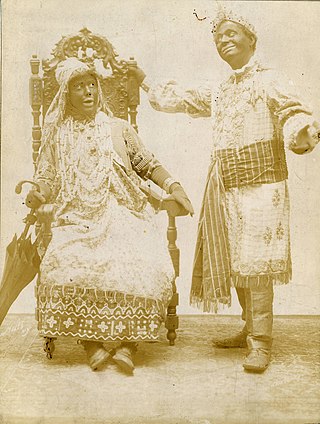
The Ham Tree is a "musical vaudeville" in three acts with music by Jean Schwartz, lyrics by William Jerome, and a book by George V. Hobart. A popular success from its debut in 1905, the work toured for several years; including three separate runs on Broadway. The work was created as a starring vehicle for vaudeville and minstrel show stars James McIntyre and Thomas Heath who were known for their work as blackface performers. The work incorporated several of their prior popular routines and sketches from their work on the vaudeville stage in order to appeal to their fan base. The concept of a "ham tree", along with other humorous trees like an "egg tree", was a repeating gag in their works dating back to their performances in The Georgia Minstrels in the 1890s and early 1900s. Following its initial tour, the work was revived by McIntyre and Heath several times, and was later heavily revised and retitled Hello, Alexander for a Broadway staging in 1919.
Owen Murphy was an American songwriter, film maker, and writer for radio, film, and theatre. He worked as a lyricist, composer, and playwright for Broadway musicals and as a songwriter for Tin Pan Alley in the 1920s and 1930s. As a film maker he was an early maker of industrial films. He also was a writer for comedian Joe Cook for both the stage and radio.

Albert Gumble was an American composer, pianist, music arranger, and songwriter. After graduating from the Auditorium School of Music in Cincinnati, he lived and worked briefly in Chicago during the early years of the twentieth century before moving to New York City where he worked as a Tin Pan Alley composer of ragtime pieces and songs. As a songwriter he was particularly associated with dixie tunes. He also was a prolific music arranger and contributed music to several Broadway musicals. From 1938 until his death in 1946 he was a resident pianist at the Ansonia Hotel.




















